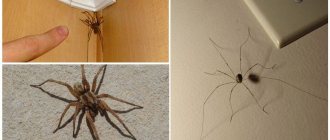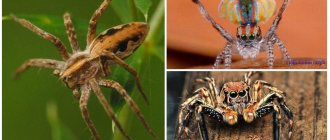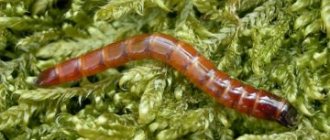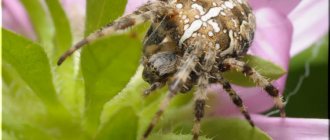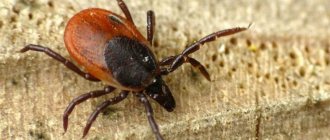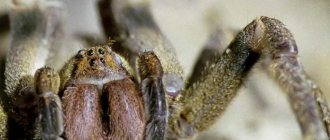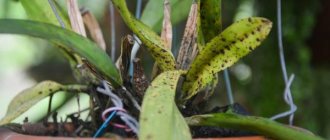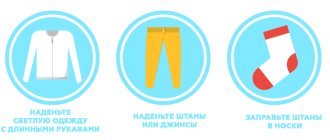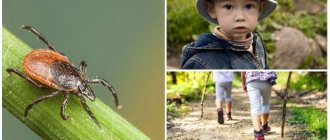People who come to Crimea on vacation are often interested in the question of what dangers may lie in wait for them there, besides crumbling cliffs and storms at sea. Those who are afraid of arachnids are very concerned about which spiders in Crimea can be really dangerous.
Among the real spiders in Crimea there are few species with strong poison. Some arthropods are intimidating in size, but are not dangerous to humans. And this is for the best, since on the peninsula you can find representatives of all types of spiders, living in the southern regions of Europe and a little in the northern ones.
Let's put a cross: biting cross spiders
In many spiders, females are dangerous to humans - they are significantly larger than males (they are simply unable to bite through the skin). This is also true for cross spiders. There are several varieties of them (common Araneus diadematus, diamond-shaped), but they are all similar in habitat, appearance and influence on people.
Krestoviki weave trapping nets and hang them between trees and bush branches. All of them are not rare; many have seen them. A distinctive feature is a light pattern like a cross on the abdomen. These are large spiders - a female, hanging with her legs spread out in the web, can reach 4 cm in “diameter”. They feed on insects.
A cross bite is not dangerous, but can be painful and cause significant local inflammation (up to and including slight necrosis of the tissue around the wound). No special treatment is needed - just lubricate the area with anti-inflammatory agents. If the manifestation is severe, you can take an antiallergen.
What to do if bitten by a spider
If you are bitten by a spider, you need to act quickly:
- Treat the bite site with alcohol, hydrogen peroxide or a slightly pink solution of potassium permanganate.
- Apply a cold compress to the affected area
- Call an ambulance.
Carefully!
- Do not apply a tourniquet, as this can lead to disruption of blood supply and necrosis of the limb.
- Do not crush a spider crawling on your skin or clothing; brush it away.
Argiope: eight-legged wasp
Argiope (Agriope bruennichi) is a large spider, comparable in size to cross spiders. He is beautiful - information for those who can generally see beauty in such animals. Its mode of existence is similar to the little cross, only the first one more often hangs its mud in the grass. It has a characteristic black and yellow stripe color, like a hornet, which is why it is popularly called the wasp spider or “zebra”. Several subspecies of Argiope are found in Crimea.
Argiope is not life-threatening, but can be frightening - its resemblance to a flying insect is enhanced by the sensation of a bite. It bites painfully and usually unexpectedly (in thick grass it is harder to notice than you might think).
Inflammation occurs - exactly the same as in the case of a wasp sting. The difference can be determined by looking closely at the punctures - the wasp leaves one, and the spider leaves two. The treatment is also “anti-wasp” - lubricate it with something anti-allergic. In the vast majority of cases, pain, redness and swelling appear quickly, but after a couple of hours they completely disappear on their own.
What is the situation with spiders in Krasnodar
Environmentalists note that the climate is gradually changing. Spiders that previously lived in Crimea began to appear in the Krasnodar Territory. Thus, in the summer of 2015 alone, 3 bites of poisonous insects were registered that had not previously settled in the surrounding areas.
Patients noted that they were bitten by a spider that they had not seen before. Immediately after the attack, the victims developed symptoms of allergies and body intoxication. This forced people to immediately seek help from doctors.
Every year the number of “foreign” insects is rapidly increasing. Doctors say spiders are often not the first to attack
This is why it is important to be careful and inspect shoes and clothing before putting them on.
Recently, sak has appeared in the Krasnodar region. Previously, this spider lived only in Germany and Australia. Poisonous, but not lethal.
If you want to know more about poisonous spiders in Russia, then watch this video:
Source
Tarantula in Crimea: a serious matter
The South Russian tarantula (Licosa singoriensis) was recorded in Crimea only in recent years, but during this time it managed to become trivial on the peninsula and cause a lot of trouble. He is a burrowing, steppe animal, lives in dry areas (in the region of Kerch, Evpatoria), where there is vegetation, and digs holes in the ground (or engages in raider seizures of mice, and kills the owners). The spider does not weave webs - it waits in the hole for the prey to approach, and then with a sharp throw it pounces on it and paralyzes it with its bite. Spiderlings that hunt in this way are called “wolves.”
They are gray in color, shaggy - this can be seen if you look closely, with powerful legs. Yes, these are the largest spiders in Crimea. Their body length sometimes reaches up to 3 cm, with outstretched legs twice as long, but they rarely take this position. The females guarding the cocoons are especially dangerous (they look exactly like cocoons, only with a rather non-standard weave). They often climb into the tents of inattentive tourists.
Tarantulas are dangerous animals. In Italy and Spain in the Middle Ages, it was believed that the only way to survive after their bite was to dance a grueling dance for a long time (yes, this is how the famous tarantella appeared). In fact, it is quite difficult to die (although it is possible with an enhanced reaction). But significant pain, swollen lymph nodes, nausea, rapid heartbeat, fever and difficulty breathing are traditional.
The victim is advised to drink plenty of fluids and take an antihistamine (the sooner the better). Immediately after contact, the wound can be cauterized (with gray from a match head). A spider is not a snake; it pierces the human body only a couple of millimeters, so the procedure will be both effective and not too painful. But tourniquets cannot be applied. If the reaction turns out to be pronounced, you need to fly to the doctor at full speed. Patients with allergies to a tarantula bite can die from cardiac arrest or suffocation.
How to protect yourself while hiking. Simple rules
Be especially careful in the evening and at night, when arthropods are most active. Try to walk in closed shoes. When collecting wood for a fire, first turn over branches or sticks with your feet to make sure that no one is under them.
Boots. Try not to leave your boots outside the tent overnight. If you don't feel comfortable with them in your tent, hang them from a tree or tuck a sock into the top. Be sure to shake them out in the morning. Tent. Treat the entrance to the tent with repellent. At any time of the day, the entrance to the tent must be closed with a zipper. Sleeping bag. Before going to bed, shake out your sleeping bag. Cloth. If clothes have been left outside for some time, it is also a good idea to shake them out. Medicines. Carry antihistamines with you in case of an allergic reaction from a bite.
Now you know about all the potentially dangerous inhabitants of Crimea. If reasonable precautions are taken, the risk of threat to life and health is minimal.
Do not forget that the most poisonous on the Crimean peninsula is karakurt, the poison of which is several times stronger than the poison of a rattlesnake. The bite of other arachnids in Crimea is not fatal and does not pose a serious danger to a healthy person, but allergy sufferers, children and people with weakened immune systems remain at risk.
Emergency care for snake bites and farts. Video from Dr. Komarovsky
Spider from the basement
Poisonous spiders are found everywhere in Crimea. A relative of the tarantula, the cellar arachnid Segestria florentina, is similar in everything to the first, except for the area of residence - it loves dark, rather damp areas, in which you most often do not expect to see such an insect.
The cellar spider is smaller and darker than its counterpart (usually bluish-black or gray-brown), and does not have the characteristic light rings on its legs. You can meet it under stones, in ravines and, naturally, in basements, cellars, vegetable stores, and garages.
The health risk when meeting him is negligible. But muscle discomfort, swelling, numbness of the affected part of the skin, sometimes spasms, increased excitability are common signs. Treatment is anti-inflammatory drugs externally and antihistamines internally. Everything should go away in a few hours.
Among the burrow spiders of Crimea, the black eresus (Eresus kollari) is also dangerous. It is unclear which colorblind person gave it its name, since the striking feature of the spider is its bright red abdomen with four black dots. The bite causes local inflammation and prolonged pain. But eresus are rare and even less likely to emerge from their burrows.
Karakurt - a poisonous inhabitant of Crimea
The karakurt is recognized as the most dangerous representative of spiders. It feeds on insects. Favorite habitats are rodent burrows, from which the spider easily expels the inhabitants. Even if the mouse decides to resist the karakurt, it instantly dies from its bite. Also settles between stones, in rock cracks. It places its trapping nets in the grass, in the steppes and even in summer cottages. From Turkic the name “karakurt” is literally translated as “black worm”; a photo of the dangerous spider of Crimea is presented above.
What does the most dangerous spider in Crimea look like:
- Sexually mature females are rich black in color with a glossy sheen, up to 2 cm long.
- The length of males does not exceed 7-8 mm.
- Juveniles and males have 13 red spots on the abdomen. Sometimes they are framed with a white border.
- Two pairs of eyes help to navigate well during the day and at night.
- Random networks are located mainly near the ground.
Karakurts are very prolific. Periodically, at intervals of 10-12 or 25 years, there is a massive outbreak of population growth. They spend winter time in cocoons, several of which are suspended in nests. In mid-spring, the young generation appears and is carried away on the web by the wind. At the end of June, having become sexually mature, females and males look for shaded places and weave nets for mating.
Interesting! Due to the bloodthirstiness of the female during mating, the karakurt is also called a black widow. The mating games of the female are very peculiar - at the end of the process, she eats the male. The female has an excellent appetite: her network for mating can simultaneously contain up to 5 candidates.
The males' life cycle ends in mid-July. After mating, females look for new places, weave a network and lay offspring. After the last laying of eggs they die.
How karakurts bite
Representatives of the black widow genus are not characterized by aggressiveness towards humans. Only if they sense danger do they defend their lair - only in emergency cases are they able to attack people. Most often, this type of spider in Crimea bites accidentally. This is due to the peculiarity of their reflexes. When pressed on the abdomen, they release poison; for this reason, a spider crawling on the body should not be slammed, but carefully thrown off.
The greatest threat to humans is the female karakurt, while males, due to their small size, are not able to bite through human skin
On a note! After picnics or trips to nature, it is recommended to inspect things, as spiders can easily get into them. It is best to walk through thickets of grass in closed high shoes, and to work in summer cottages and fields with gloves.
The concentration of poisonous components in karakurts is 15 times higher than in a rattlesnake. This feature is due to the fact that spiders wage a constant fight against rodents and other small mammals, and to neutralize them a strong poison is needed. In humans, the probability of death after a bite is 2-4%. The poison has a neuroparalytic effect.
Symptoms of a karakurt bite:
- the appearance of severe burning pain, which intensifies and spreads throughout the body within 15 minutes;
- difficulty breathing;
- dizziness, possible bluish discoloration of the skin on the face;
- disturbances of heart rhythm and kidney function;
- cramps, muscle spasms in the abdominal area;
- depressive state, the appearance of a feeling of irresistible melancholy and fear of death.
On a note! The sensations of the bite field depend on the person’s pain threshold. There are cases when people in a dream did not notice at all that they had been bitten by a spider.
What to do if you are bitten by a karakurt:
- The most effective way to eliminate the consequences of a bite from the most dangerous spider in Crimea is to administer a serum. However, it is not always available at medical centers. In its absence, an intravenous injection of potassium manganese or calcium gluconate is administered. The need for a second injection is determined by the condition of the victim.
- In the field, the cauterization method, which was developed by Marikovsky, is used. Immediately after the bite, in order to neutralize the effect of the poison, 3 matches are applied to the wound (heads to the wound), and the fourth is set on fire. High temperature destroys the protein structure of the poison and thereby avoids poisoning the body.
Attention, black widow
“Black Widow” is the name of the American variety of this spider. But the Crimean one is no better. The name explains not so much the female’s habit of snacking on her husband after mating (many varieties of arachnids do this), but rather the real danger to humans.
Karakurt (Latrodectus tridecimguttatus) is the scientific name of this creature. Translated: “black worm.” You should only be afraid of spiders - the males are small, often cannot bite through the cover, and they have little poison. The female is an awkward-looking creature with a body up to 2 cm long, and the lion’s share falls on a black abdomen with or without bright red spots. The remaining parts of the spider are pure black, glossy. It lives in burrows and places its nets low above the ground.
Karakurts are the most poisonous spiders living in Crimea. Their venom is similar to that of rattlesnakes, only 15 times stronger. The mortality rate is, of course, lower - the dose is not the same. But after the bite the following appear:
- pain (in the affected area and throughout the body);
- convulsive conditions;
- heartbeat disturbances;
- difficulty breathing;
- disorders of the kidneys;
- dizziness;
- cyanosis (blueness of the face);
- depression, panic attacks;
- abdominal cramps.
You cannot self-medicate if you are stung by a karakurt - rush to the doctor as quickly as possible. The optimal treatment option is the introduction of a special serum (produced only in Uzbekistan, costs about $1,000 per dose). If it doesn’t turn out to be there, Crimean doctors know alternative options.
Many in Crimea are also afraid of salpugs - these are scary light-colored (sometimes white) creatures with huge jaws. You should be afraid of them, but the salpuga is not a spider, but a phalanx (something between spiders and scorpions). But in general, you need to carefully look around and always have at least diazolin with you, and better yet, diphenhydramine. We hope that our article will help you avoid troubles associated with poisonous spiders in Crimea. In conclusion - an interesting video, enjoy watching!
Liked? Share with your friends!
Argiope - the most original spider of Crimea
The color of the spider's abdomen is very similar to that of a wasp. Alternating yellow and white stripes give the arachnid an unforgettable appearance. This representative is by no means uncommon in Crimea and can be found in the steppe and forest zones.
Like the black widow, the female Argiope devours her suitors
Because of the striped color, many more names appeared: zebra, wasp spider. Body dimensions do not exceed 1.5 cm. Peak activity occurs in the evening and at night. Spiders weave webs of complex design. At the same time, it takes them no more than an hour to create a fishing net. The individual itself is located in the center of the structure and hangs head down. Grasshoppers, locusts, and grasshoppers are the spider’s favorite delicacies.
An argiope bite does not pose a mortal danger to humans. The affected area may develop suppuration, abscesses, and in the worst case, the development of tissue necrosis. People prone to allergies may experience allergic reactions to spider venom.
Important! No matter what spider bites you, you should never apply a tourniquet. Poor circulation can lead to limb necrosis. It is also forbidden to cut wounds and incisions near them.
Habitats and lifestyle
To avoid meeting representatives of this species, you need to know their habitats and lifestyle features. Most often, tarantulas inhabit the following places.
- Steep slopes along rivers
where there is sufficient water. - Semi-deserts and steppes are also favorite places .
- In rare cases, individuals can be found in forests where groundwater is available .
Behavioral features include their active nocturnal lifestyle , at which time they are busy searching for prey. During the daytime they usually sleep in burrows.
A distinctive feature in behavior can be called care for offspring ; females lay eggs and protect the clutch until the spiders are born.
Tarantula. Crimean tarantula. Tarantula bite, help with a bite.
is the common name for several species of large spiders belonging to the wolf spider family. Tarantula is an invertebrate animal. Its body, consisting of two parts - the cephalothorax and abdomen, is covered with small hairs. Tarantulas are the largest spiders living in Ukraine, the size of large individuals reaches 4 cm. The spider is colored brown-gray-black, and those that have not shed for a long time have a red tint. Very often, other large spiders, such as tarantulas, are mistakenly called “tarantulas.”
Crimean tarantula. Tarantula habitat.
The name tarantula comes from the Italian city of Tarantum. People in the Middle Ages believed that anyone bitten by a spider would become ill with a terrible disease - tarantism. It was expressed by complete indifference to everything and always ended in death. The only means of salvation was the wild dance of the tarantella. To get rid of the disease, you had to dance until you were completely exhausted.
Tarantulas love dry areas such as steppes or deserts. In Ukraine, the tarantula is found in the steppe part of Crimea. Tarantulas are nocturnal predators. During the day, they take refuge in vertical burrows up to 50 cm deep. Sometimes they choose natural shelters for shelter - various cracks and faults. To protect themselves from frost in winter, tarantulas deepen their burrow and bury the entrance.
At night, spiders come to the surface and begin hunting. The tarantula's diet consists of various insects, smaller in size than the spider itself. Tarantulas do not weave trapping nets; they use the web only to build an egg cocoon and cover the walls of the burrow.
Tarantula bite.
All tarantulas are poisonous, but this does not mean that they are particularly dangerous to humans.
Their venom is enough to paralyze a small animal, but for people a tarantula bite is equivalent to a wasp sting, well, maybe a little stronger. Swelling appears at the site of the bite, the venom causes pain and numbness, and the temperature often rises. Only a severe allergic reaction can lead to death.
Tarantulas never attack anything larger than themselves. And from this it follows that he will not bite a person first, only in case of self-defense, for example, when you accidentally pressed him.
First aid for a tarantula bite.
- Wash the bite area thoroughly with plenty of soapy water.
- Apply a tourniquet to the bitten limb and immobilize it as much as possible.
- Apply ice to the bite site.
- Drinking plenty of fluids is recommended. Then some of the poison will be eliminated faster in the urine.
- For adults, you can give aspirin or acetaminophen. It is better to give paracetamol to children.
- If possible, crush the tarantula and apply blood to the bite area. The fact is that his blood contains an antidote to his own poison.
- If an allergic reaction occurs, it is better to take the victim to the hospital as soon as possible.
Photo of the tarantula:
Externally, in our usual understanding, local spiders are similar to: karakurt, tarantula, agriope and salpuga (phalanx). But! There are also other dangerous arachnids here - ticks and even the Crimean scorpion - yes, all this is one class of arachnids. The ringed scolopendra is also found in Crimea. Stinging insects include the hornet, wasp, gadfly and the ubiquitous mosquitoes.
Scolopendra. Features of the Crimean scolopendra. How to protect yourself from Crimean centipede.
Scolopendra is an armored centipede that looks like a long, dark brown worm, sometimes with a greenish tint. It mainly lives in tropical countries and only a few species are content with a temperate climate. In Crimea there is a ringed scolopendra, reaching 12 cm in length. The Crimean scolopendra loves dark and slightly damp places, hiding under stones, in cracks in the soil, under old trees. During the day it leads a secretive lifestyle, but after sunset it goes out hunting. I must say that this centipede is an excellent hunter! The scolopendra grabs the victim with its front legs, and then plunges its poisonous jaws into it. Eats very slowly. The diet of the Crimean centipede consists of various insects, beetles, larvae, arachnids, and does not disdain mollusks. On hot sunny days, food often finds itself to the hunter, who hides from the sun in a cozy hole or crevice.
Read more…
Destructive flora: dangerous plants of Crimea
Is it dangerous to walk through the forests of Crimea? To a certain extent, yes, because on a walk you may come across beautiful and attractive plants that are considered poisonous.
Crow's eye. A toxic plant, but its dark blue berries, similar to blueberries, are especially poisonous. If you eat such “beauty”, then severe poisoning is guaranteed.
Crow's eye is a poisonous plant, the fruits of which can be confused by both children and adults with blueberries.
Yasenets (Burning Bush, Asterisk). The lilac or pink flowers of this plant cause severe skin burns within a few hours of touching it. The ash tree is not dangerous to the body, but after it heals, scars remain. Grows in all forests of Crimea.
Ash tree has a pleasant citrus aroma, but even inhaling the pollen of this plant can cause a burn to the respiratory organs.
Aconite (wolf root, king potion). The plant with blue flowers grows in beech forests and is considered completely poisonous. Affects the central nervous system, causing convulsions and paralysis of the respiratory organs.
Aconite is unknowingly used to brew tea, which leads to severe headaches and hallucinations.
Belladonna. A plant with a purple fruit like a small cherry. If you eat it, it begins to burn in your mouth, it becomes difficult to swallow, your heart rate increases, and hallucinations are possible. If a person is not helped in time, the outcome can be very unfavorable.
Belladonna berries, which look appetizing in appearance, taste like cherries, which is why children are often poisoned by this plant.
Bollygolov. Looks like a parsley bush in the flowering stage. Both the leaves and fruits of this plant are dangerous - they paralyze muscles, legs, and the skin loses sensitivity. Respiratory paralysis is especially dangerous.
Hemlock venom can cause food poisoning, convulsions, and paralysis.
First aid for poisoning by poisonous plants
: induce vomiting to cleanse the stomach, take activated charcoal, an antipyretic. In the case of black eye, vomiting cannot be induced; only the use of activated carbon is recommended. In the case of plants that cause skin burns, wash the affected area with soap and use anti-burn ointment.
Beautiful and unusual entomofauna of the peninsula
The most beautiful insects in Crimea live not only in protected areas. Unusual specimens are found in parks, squares and even in private plots.
- Scolia giant wasp. The species is on the verge of extinction and is therefore listed in the Red Book. The size of the female reaches 5.5 cm. Against the background of a black body, wide purple wings and a bright yellow sternum look impressive. The entire body is covered with black and red hairs. The insect not only has beautiful bright colors, but also an extraordinary lifestyle. Scolia larvae parasitize the larvae of rhinoceros beetles, as well as beetles. The insect builds numerous tunnels in the soil, looks for a victim, paralyzes it and lays one egg at a time. So the offspring of Scolia do not experience a lack of nutrients, gradually eating away the insides of the host, consuming vital organs only at the end. Giant scolia are not only a decoration of the Crimean entomofauna, but are also among the largest insects in Crimea.
- The Xylocopa is a solitary hunter bee, often called the purple bumblebee because of its coloration. The size of the insect reaches 3 cm. The body is black metallic, densely covered with black hairs, decorated with small transparent wings with a purple tint. It does not have an aggressive disposition; it ignores human presence.
- The largest butterflies in Crimea are the Saturnia pear, also known as the peacock-eye, with a wingspan of 15 cm, swallowtails with a wingspan of up to 95 mm, podalirium, which has a wingspan of 7.2 cm, and polyxena (wingspan of 5.4 cm). In addition to their size, butterflies are distinguished by the original pattern on their wings. Seeing polyxena is very rare, as the species is on the verge of extinction. Only 4 species of vines serve as food sources for the caterpillars of this butterfly.
- Several species of hawkmoth butterflies have been preserved in Crimea: oak, oleander, etc. Occasionally, a rare species is found - the Death's Head. The individual is notable for having a pattern on its chest that resembles a human skull. The Death's Head caterpillar is also characterized by a memorable appearance - bright yellow, yellow-blue, yellow-lemon with blue oblique stripes. At all stages of development, hawk moths of this species are capable of making sounds.
Insects of Crimea
- Mantises. The size of individuals reaches 7.5 cm in the female. Males are somewhat smaller. The color depends on the surrounding vegetation and varies from brown to green shades. There is also a rare, unusual species of praying mantis in Crimea - the striped empusa. The insect is difficult to see, despite the fact that it reaches 6.5 cm in length. The body of the mantis is so thin that it looks more like a stick or a blade of grass.
- The Crimean ground beetle is one of the most beautiful beetles in Crimea. Color green, blue tones. The coarse-grained covering of the body creates an optical illusion that the insect changes its color and shimmers in different shades.
- Grasshopper Akrid. The harmless insect captivates with its size. Females grow up to 8 cm.
- Speaking about the insects of Crimea, one cannot help but recall the night singers - cicadas. Unlike crickets, their singing can only be heard during the daytime. Only males are endowed with singing abilities. The females are silent.
- Rhinoceros beetle. A rather rare specimen, which leads to a reduction in the number of Scolia. Only males have a horn. Insects grow up to 5cm. The shell appears varnished, long legs protrude from under it, and the abdomen is densely covered with hairs. The larvae of the rhinoceros beetle are very similar in appearance to the larvae of the cockchafer, which is why they are often destroyed.
- Stag beetle. No less beautiful than a rhinoceros. It is smaller in size than its fellow giants from Europe. Females also lack horns. Rarely found in mountain forests. Red Book insect.
- The dragonflies of Crimea deserve special attention. Entomologists have studied 60 species of these insects. All of them are predators and amaze with their variety of colors. Among the large specimens, the most notable are the large rocker, the lattice dragonfly with blue wings, and the emperor's watchman.
A description of all the insects of Crimea would not fit in a multi-volume encyclopedia. Entomologists have been studying them for more than 200 years, but more and more new species are still being discovered.
